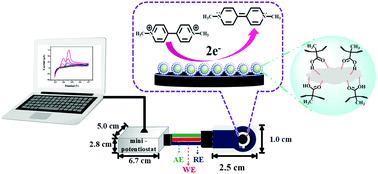Our official English website, www.x-mol.net, welcomes your feedback! (Note: you will need to create a separate account there.)
Ready-to-use paraquat sensor using a graphene-screen printed electrode modified with a molecularly imprinted polymer coating on a platinum core
Analyst ( IF 4.2 ) Pub Date : 2021-09-13 , DOI: 10.1039/d1an01278a Kanpitcha Somnet 1 , Suphatsorn Thimoonnee 1 , Chanpen Karuwan 2 , Wichayaporn Kamsong 2 , Adisorn Tuantranont 2 , Maliwan Amatatongchai 1
Analyst ( IF 4.2 ) Pub Date : 2021-09-13 , DOI: 10.1039/d1an01278a Kanpitcha Somnet 1 , Suphatsorn Thimoonnee 1 , Chanpen Karuwan 2 , Wichayaporn Kamsong 2 , Adisorn Tuantranont 2 , Maliwan Amatatongchai 1
Affiliation

|
We propose the fabrication of a novel ready-to-use electrochemical sensor based on a screen-printed graphene paste electrode (SPGrE) modified with platinum nanoparticles and coated with a molecularly imprinted polymer (PtNPs@MIP) for sensitive and cost-effective detection of paraquat (PQ) herbicide. Successive coating of the PtNPs surface with SiO2 and vinyl end-groups formed the PtNPs@MIP. Next, we terminated the vinyl groups with a molecularly imprinted polymer (MIP) shell. MIP was attached to the PtNPs cores using PQ as the template, methacrylic acid (MAA) as the monomer, ethylene glycol dimethacrylate (EGDMA) as the cross-linker, and 2,2′-azobisisobutyronitrile (AIBN) as the initiator. Coating the SPGrE surface with PtNPs@MIP furnished the PQ sensor. We studied the electrochemical mechanism of PQ on the MIP sensor using cyclic voltammetry (CV) experiments. The PQ oxidation current signal appears at −1.08 V and −0.71 V vs. Ag/AgCl using 0.1 M potassium sulfate solution. Quantitative analysis was performed by anodic stripping voltammetry (ASV) using a deposition potential of −1.4 V for 60 s and linear sweep voltammetric stripping. The MIP sensor provides linearity from 0.05 to 1000 μM (r2 = 0.999), with a lower detection limit of 0.02 μM (at −0.71 V). The compact imprinted sensor gave a highly sensitive and selective signal toward PQ. The ready-to-use MIP sensor can provide an alternative approach to the determination of paraquat residue on vegetables and fruits for food safety applications.
中文翻译:

即用型百草枯传感器,使用石墨烯丝网印刷电极,在铂核上涂有分子印迹聚合物涂层
我们建议制造一种新型即用型电化学传感器,该传感器基于用铂纳米粒子修饰并涂有分子印迹聚合物 (PtNPs@MIP) 的丝网印刷石墨烯糊电极 (SPGrE),用于灵敏且经济高效地检测百草枯 (PQ) 除草剂。用 SiO 2连续涂覆 PtNPs 表面和乙烯基端基形成 PtNPs@MIP。接下来,我们用分子印迹聚合物 (MIP) 壳终止乙烯基。MIP以PQ为模板,甲基丙烯酸(MAA)为单体,乙二醇二甲基丙烯酸酯(EGDMA)为交联剂,2,2'-偶氮二异丁腈(AIBN)为引发剂,将MIP连接到PtNPs核上。用 PtNPs@MIP 涂覆 SPGrE 表面提供了 PQ 传感器。我们使用循环伏安法 (CV) 实验研究了 PQ 在 MIP 传感器上的电化学机制。PQ 氧化电流信号出现在 -1.08 V 和 -0.71 V vs.Ag/AgCl 使用 0.1 M 硫酸钾溶液。通过阳极溶出伏安法 (ASV) 进行定量分析,使用 -1.4 V 的沉积电位 60 秒和线性扫描伏安法溶出。MIP 传感器提供 0.05 至 1000 μM ( r 2 = 0.999) 的线性度,检测下限为 0.02 μM(-0.71 V)。紧凑的印迹传感器对 PQ 提供了高度敏感和选择性的信号。即用型 MIP 传感器可为食品安全应用中测定蔬菜和水果上的百草枯残留提供另一种方法。
更新日期:2021-09-22
中文翻译:

即用型百草枯传感器,使用石墨烯丝网印刷电极,在铂核上涂有分子印迹聚合物涂层
我们建议制造一种新型即用型电化学传感器,该传感器基于用铂纳米粒子修饰并涂有分子印迹聚合物 (PtNPs@MIP) 的丝网印刷石墨烯糊电极 (SPGrE),用于灵敏且经济高效地检测百草枯 (PQ) 除草剂。用 SiO 2连续涂覆 PtNPs 表面和乙烯基端基形成 PtNPs@MIP。接下来,我们用分子印迹聚合物 (MIP) 壳终止乙烯基。MIP以PQ为模板,甲基丙烯酸(MAA)为单体,乙二醇二甲基丙烯酸酯(EGDMA)为交联剂,2,2'-偶氮二异丁腈(AIBN)为引发剂,将MIP连接到PtNPs核上。用 PtNPs@MIP 涂覆 SPGrE 表面提供了 PQ 传感器。我们使用循环伏安法 (CV) 实验研究了 PQ 在 MIP 传感器上的电化学机制。PQ 氧化电流信号出现在 -1.08 V 和 -0.71 V vs.Ag/AgCl 使用 0.1 M 硫酸钾溶液。通过阳极溶出伏安法 (ASV) 进行定量分析,使用 -1.4 V 的沉积电位 60 秒和线性扫描伏安法溶出。MIP 传感器提供 0.05 至 1000 μM ( r 2 = 0.999) 的线性度,检测下限为 0.02 μM(-0.71 V)。紧凑的印迹传感器对 PQ 提供了高度敏感和选择性的信号。即用型 MIP 传感器可为食品安全应用中测定蔬菜和水果上的百草枯残留提供另一种方法。



























 京公网安备 11010802027423号
京公网安备 11010802027423号